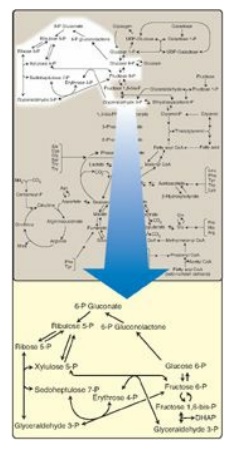Pentose Phosphate Pathway and Nicotinamide Adenine Dinucleotide Phosphate
| Home | | Biochemistry |Chapter: Biochemistry : Pentose Phosphate Pathway and Nicotinamide Adenine Dinucleotide Phosphate
The pentose phosphate pathway (also called the hexose monophosphate shunt) occurs in the cytosol of the cell.
Pentose Phosphate Pathway and Nicotinamide Adenine
Dinucleotide Phosphate
OVERVIEW
The pentose phosphate
pathway (also called the hexose monophosphate shunt) occurs in the cytosol of
the cell. It includes two irreversible oxidative reactions, followed by a
series of reversible sugar–phosphate interconversions (Figure 13.1). No
adenosine triphosphate (ATP) is directly consumed or produced in the cycle.
Carbon 1 of glucose 6-phosphate is released as CO2, and two reduced
nicotinamide adenine dinucleotide phosphates (NADPHs) are produced for each
glucose 6-phosphate molecule entering the oxidative part of the pathway. The
rate and direction of the reversible reactions of the pentose phosphate pathway
are determined by the supply of and demand for intermediates of the cycle. The
pathway provides a major portion of the body’s NADPH, which functions as a
biochemical reductant. It also produces ribose 5-phosphate, required for the
biosynthesis of nucleotides, and provides a mechanism for the metabolic use of
five-carbon sugars obtained from the diet or the degradation of structural
carbohydrates.

Figure 13.1 Pentose phosphate
pathway shown as a component of the metabolic map (see Figure 8.2, for a more
detailed view of the metabolic pathways). P = phosphate; DHAP =
dihydroxyacetone phosphate.
Related Topics
